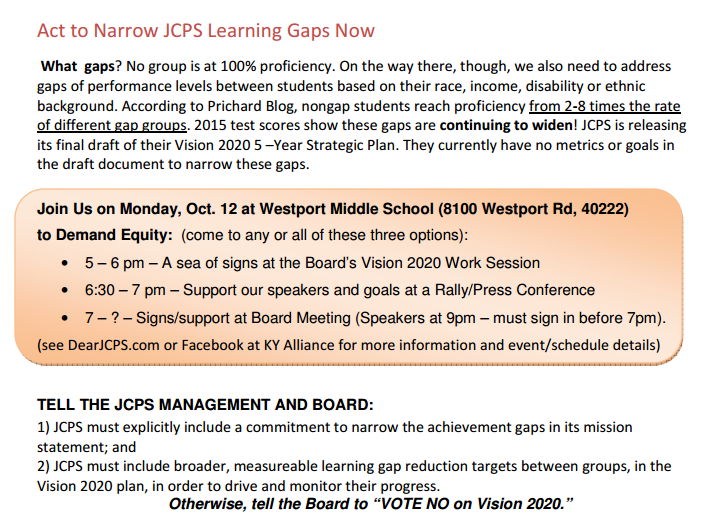# DitchTheGap Coalition Actions and Press Conference before and during JCPS Board meeting, Westport Middle School, Monday October 12
As of 2014, 45% of all Jefferson County Public Schools (JCPS) students reached math and reading proficiency. For Latino students, though, that number was 40%—less than 3/4 the rate for all white students. For African American students, it was only half the rate for white students. Only one out of three students from families with low incomes was proficient. Special needs students and English language learners scored even lower. For 2012-2015, the increase in the % proficient of all these ”gap” students was less than one quarter of the JCPS target. The gaps are clearly real. And just as clearly, JCPS does not have the right goal and plan in place to narrow them.
Help us change the course of JCPS.
Below are talking points for contacting the JCPS Superintendent, the Board Chair, and your School Board member. Share your stories about the impacts of the gaps on your family, too. And join us again at the Van Hoose Center for the final vote on October 26! Click here to contact your board member.
#DitchTheGap Coalition: Facts and Talking Points– Gap reduction in JCPS
- More than 150 years ago, Horace Mann said that universal education is the “balance wheel” of American society. JCPS’ mission needs to emphasize this goal. JCPS’ budget and programs need to be evaluated on their impact moving toward it. Twelve (+) years in JCPS must reduce the learning and skills gaps compared with advantaged students and create a more level competitive field at graduation. Failing that, JCPS is part of institutionalizing the race and class inequity that persists in our society and community.
- There is precedent. Seattle Public Schools Policy #0030 (8/15/2012) on Ensuring Educational and Racial Equity says in part:
“…Seattle Public schools will: Raise the achievement of all students while narrowing the gaps between the lowest and highest performing students; …”
This does not mean giving up all improvements for higher-performing students. It is a matter of rebalancing budget priorities, resources and programs—and adding resources when necessary .
- KY Department of Education data for 2012-2014 showed that math and reading proficiency rates rose for every JCPS demographic group— by race/ethnicity, family income level, English language learners, and special needs . However, in every comparison, the generally more-advantaged white student group rose by more percentage points than the specific gap group. By this proficiency measure, those gaps To close gaps, we need improvement in the so-called “gap” groups at a faster pace than in higher- performing students.
- Proficiency gains in 2015 leveled off at a “plateau ”,in the words of Superintendent Hargens. In reality, since 2012, combined math and reading scores for the combined (“nonduplicated”) gap group went up far slower than targeted. The increase was less than one quarter of the JCPS Vision 2015 goal for that period. This calls into question the credibility and advisability of JCPS’ call to “stay the course” for five more years.
- “What would a commitment be without metrics…?” –Superintendent Donna Hargens (February, 2015)
JCPS leadership –in concert with teachers and other experts– must research available alternatives to institute broader, measurable indicators of demonstrated student progress in learning gap reduction across all groups, grades and performance levels. Not only would these be more timely and useful to classroom teachers’ ongoing adjustments for student learning, they would be less likely to be “gamed” for short-term improvements against state and school goals. Using the intense, once-a-year state testing may be a requirement currently imposed on JCPS, but they should be used only as an interim option. It makes no sense to enshrine these assessment measures for the next five years.
- A measurable learning gap target would be a new driver, a new lens for every evaluation and evidence-based Here are some possibilities from this year’s Board agendas where Board actions might have changed: construction/rehabilitation decisions; more aggressive hiring of minority teachers; more engaging magnets–without high academic thresholds for initial acceptance; fine-tuning student/teacher ratios based on classroom demographics; intensive, extended pre-K development programs; budgets for faster rollout of programs for pre-emptive teaching, modeling, and assessing of behavior instead of suspensions. The opportunities for impact are endless.

